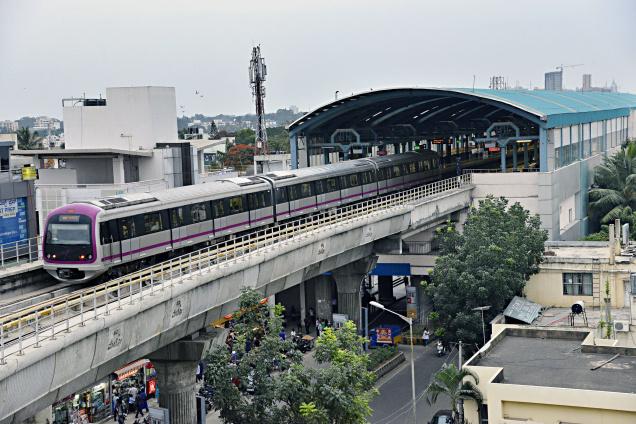Bangalore, October 7: In the two years since the inauguration of Reach One of Metro Phase One, connecting Byappanahalli and M.G. Road, life has remained largely unchanged for the average commuter.
Given that the service presently covers only six kilometres, the Metro is yet to become the preferred mode of transport for people who live in East Bangalore neighbourhoods of Indiranagar, Ulsoor, Old Madras Road and Byappanahalli. The impact of the line on vehicular traffic is negligible.
“Right now it’s just a joy ride. It feels like the Namma Metro authorities have put this line just to give people an idea of how things might be when the full project becomes functional,” says D.R. Narendra Kumar, a Kannada professor who lives in Jogupalya.
The professor’s assertion is borne out by the hordes of tourists who ride the Byappanahalli line just for thrills – cameras and all. “Earlier people used to go to Cubbon Park for a toy train ride. Now they take the Metro,” laughs Mohan Raj, a cellphone shop owner in Indiranagar.
When Reach One was inaugurated in October 2011, elected representatives as well as bureaucrats promised that Underground Two (M.G. Road-Magadi Road) would be inaugurated within a year. Owing to several technical problems, particularly resistance to land acquisition, this stretch is still some distance from completion.
“Had this stretch been commissioned, the Metro would actually have had some value as it would have connected us to the [Majestic] Railway Station,” says Parakram Chetri, a security guard who works in C.V. Raman Nagar. Aruna Prakash (46), a bank employee, shared, “I live in Indiranagar and Metro serves only 20 per cent of my travel due to its limited connectivity. How can anyone completely rely on it as a staple mode of transport everyday?”
Lakshminarasimhaiah, a Cubbon Road traffic sub-inspector, says, “On M.G. Road, there has been a small but significant reduction of traffic [after the Metro line was commissioned]. But this might also be because BMTC buses are no longer allowed in that stretch.”
Bangalore’s Additional Commissioner of Police, B. Dayanand, said that while there has been no formal assessment of traffic increase or decrease after Metro, “due to its limited coverage area, we assume it has not made much difference”. Even a layman with a vague analysis can decipher that there is no change on the roads and the dependence on others modes of transport viz., buses, autos, private vehicles, continues to infest these areas.
However, the present service is still beneficial to a lucky few. Rajeshwari Ganesh, a homemaker who resides near Byappanahalli, said, “I am lucky, the Metro does help me. I take it to drop my son everyday at his school but I don’t generally see many students and corporate employees as regular commuters.”
The BMRCL claims that with a limited reach of six km, the daily ridership in Metro is about 20,000. “With the completion of Phase 1 the ridership is expected to touch one million per day,” B.L.Y. Chavan, Public Relations Officer of BMRCL, said.
Emissions down
However, as per statistics shared by BMRCL, there has been considerable reduction in emission of carbon monoxide and automobile exhaust. The energy required to transport people for the distance through Metro is less than one-tenth of that required in transporting the same number of persons by bus. Indeed, energy efficiency appears to be the only positive of the Metro facility servicing a meagre percentage of commuters.
After the baneful acquisition of land, demolition of buildings, felling of trees and narrowing of roads, residents see no purpose in having the prestigious mega-transport structure which provides no relief in any form.
Jayanthy Bhagatha (32), a resident of Indiranagar, said, “Living in this area, I have seen an increase in noise pollution, chaotic traffic jams and vehicles squeezing through roads narrowed by Metro construction. Many residents and private businesses have suffered immensely.”
Palanivelu (54), a resident of Halasuru, said, “My house collapsed during the laying of the foundation for the Metro station. I couldn’t expect any help or compensation from the BMRCL. The road gets very dusty due to constant vehicular movement and people have a hard time maintaining their houses. But, the division of road has kept traffic at bay. It is the only consolation.”
Will the Metro impact be truly felt once its reach expands?

